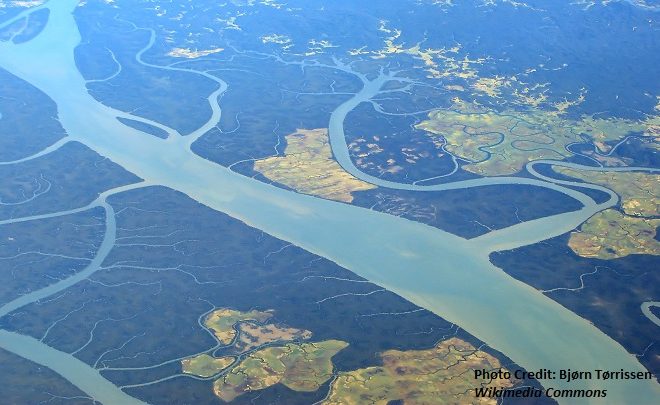Decision Looms on Myitsone Dam

The new Myanmar government faces a final decision on the highly charged issue of the Chinese-backed Myitsone Dam.
Having taken office two months ago, Myanmar’s new government faces an important decision on one of the country’s largest foreign investments, the controversial Chinese-backed Myitsone Dam. The previous government under President U Thein Sein stalled the mega hydro-power project in 2011 in response to serious concerns of environmental degradation and displacement of local ethnic communities, which brought unprecedented national and international attention to the dam.
Part of the $30 billion Confluence Region Hydropower Project (CRHP), Myitsone is the largest dam in a string of seven (with only one, Chibwe, presently operational) along the Ayeyarwaddy River in Kachin State. China’s CPI Yunnan International Power Investment Company (CPIYN) has a controlling share of 80 percent of the project with Myanmar’s Ministry of Electric Power, recently merged with the Ministry of Energy, owning 15 percent; the remaining 5 percent is owned by the Myanmar Asia World Company.
With a total installed capacity of 20,000 MW (Myitsone comprises 6,000 MW), 90 percent of the electricity from Myitsone is slated for export to neighboring China while Myanmar would accrue the remaining 10 percent “for free” – although the Sino-Myanmar joint venture in charge of the project, Upstream Ayeyawady Confluence Basin Hydropower Co. Ltd. (ACHC), stresses that the Myanmar government would have “first refusal for the rest [90%] of the electricity generated by the hydropower plant.”
Concerns Over Impact
Notwithstanding the contested provisions of the “90/10” contracts which were negotiated almost a decade ago, environmental concerns have been well-voiced. An estimated three hundred thousand people live downstream of the proposed Myitsone Dam in Kachin State, with the project having the potential to severely and irreversibly alter downstream flows critical for rice production, aquatic migratory patterns, and river salinity. Indeed, the idea that large hydropower is a clean source of energy has been increasingly contested and illustrated that it can greatly affect the environment and local community’s livelihoods who rely on it.
Added to this are questions of land displacement that often accompany large-scale investment projects in poor agricultural areas or conflict zones where disputes over land tenure are more pronounced. Flooding of the dam site (766 km2) has displaced some 12,000 local people from key cultural heritage sties in what some have called “ecological and identity theft.”
Since the stalling of the dam project, some concerns have begun to be addressed by carrying out Environmental Impact Assessments (EIAs), providing for re-settlement packages for local villagers, and undertaking more inclusive public consultation where previously there was none. However, independent recommendations to reduce the scale of the dam to two smaller projects and warnings of environmental impacts on forest clearing have been largely dismissed by the ACHC.
Much of Myanmar’s population, including many Civil Society Organizations (CSOs), remain resolutely opposed to the project with distrust of the government and anti-Chinese sentiment running high, particularly in Kachin State. Conflict is ongoing in the State and the Kachin Independence Army (KIA) is the one of the larger ethnic armed groups not to have signed the Nationwide Ceasefire Agreement last October. Bombings on the main supply routes (Myitkyina to Bhamo Road) for construction materials to the dam site and clashes near the dam occurred in 2011 with conflict ongoing across the State.
Since the breakdown of a ceasefire in 2011, conflict has caused the displacement of over 100,000 Kachin State residents particularly towards the Chinese border and the KIA headquarters of Laiza, and south to the state capital of Myitkyina and surrounding townships. Resumption of the dam project would likely exacerbate the conflict and intensify the vulnerability of citizens living in affected areas of Kachin State.
Decision Time
The new government is maintaining that recommencement of the project depends on “public approval.” The National League for Democracy (NLD) Party spokesperson U Zaw Myint Maung confirmed on March 19 that: “our policy is clear. We have special consideration for the people. We will not do it if people do not agree.” The Ayeyarwaddy is of deep historic and cultural significance to the people of Myanmar, with the issue of Myitsone unique in how it has rallied public opinion and unified a civil society front against the dam beyond Kachin.
Meanwhile, the Chinese government has continued to place pressure on Myanmar for a re-start of the project, with China’s Foreign Minister Yang Wi stating that the dam had “cleared all the approval procedures.” More recently China’s Ambassador to Myanmar, Hong Lang, met officials in Kachin State where he asserted that cancellation of Myitsone could result in a “huge amount” of compensation having to be paid. Over $800million has been spent on the project thus far, with a projected investment of $3.6 billion.
A final decision to cancel the dam or re-negotiate the contract, despite Chinese objections, would send a strong signal that the new government is attuned to concerns over the impacts of such large-scale infrastructure projects in conflict-sensitive areas as well as to public opinion. Nevertheless, the case of Myitsone also sheds light on the government’s challenge ahead. In a country in urgent need of power supply and electricity for socio-economic development and revenue, utilizing its rich hydropower potential where most resources are located in ethnic states will prove a delicate balancing act that necessitates a consultative approach involving all stakeholders.
Natasha Ikners is completing an internship at ISDP. She has a focus on conflict economies.